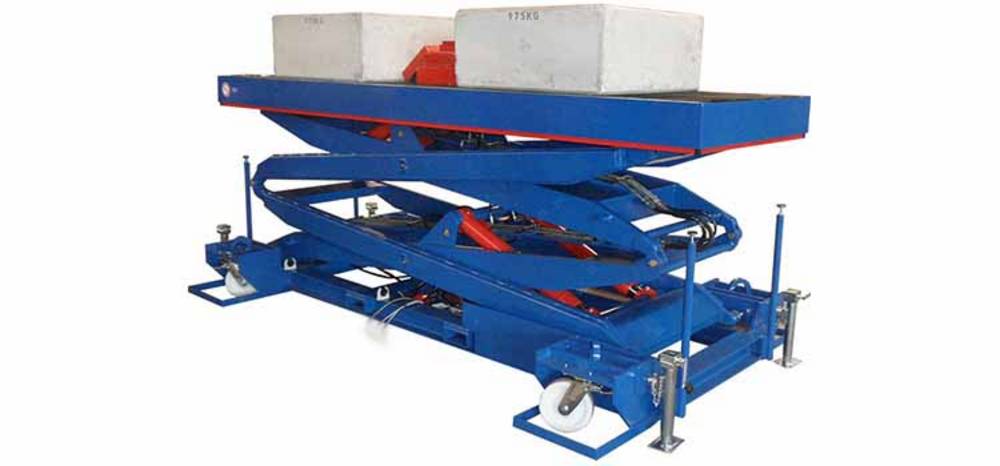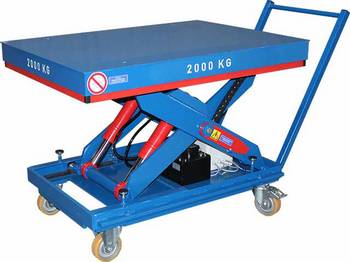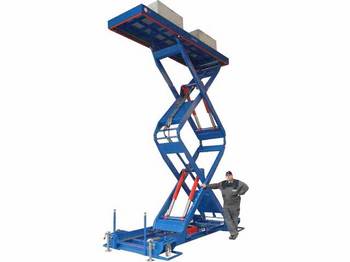About 90% of the lift tables we sell are used as stationary lift tables. However, there are various applications where a mobile lift table is more appropriate. Good examples are:
- Lift table trolleys
Lift table trolleys are used for manual load transport or as a flexible workstation in workshops, among other places (see lifting work table). - Coil loading cars
Coil loading cars are lift tables used for loading and unloading very heavy paper or sheet metal coils. In view of the high loads they are usually equipped with powered rail undercarriages. - Onward transport in production lines
Scissor lifts with rail undercarriages are often used in (semi-) automated production lines. The rail undercarriages are often fitted with end stops to achieve high positioning as well as transfer accuracy. - Aerial work platforms
The market for mobile aerial work platforms, which are mainly used for installation work at greater heights, must not to be underestimated. - Other special cases
Of course the list is not complete. There are always applications that you would not have expected yourself. A good example is this movable lift table, which is used as a counter surface for a pipe that rests on it.
Types of undercarriages
In the following we would like to present two common types of undercarriages.
Just a short note beforehand: both undercarriage types can be supplied with or without a drive. Whether a drive is required, depends on the load to be moved (can the load still be moved manually?) and on the intended use (a manually moveable lift table makes no sense in automated production plants).
Wheeled undercarriage
Wheeled undercarriages must be the most frequently used type of undercarriage. Flexible transport is made possible by a combination of swivelling and fixed castors. In addition, the handling behaviour is determined by another influencing variable: the tread. There are many different types of treads available.
Tread
Plastic treads are traditionally used in the industrial sector. It has two decisive advantages over rubber treads:
- Imperviousness
Plastic castors are less sensitive to external influences, especially chips and similar sharp objects. In addition, there is no risk of a flat tyre, nor does the tyre pressure need to be monitored regularly. - Low rolling resistance
Compared to rubber castors, this tread has a lower rolling resistance. This makes it easier for the end user to push the lift table.
We mainly use polyurethane and polyamide as plastic treads. Polyamide is always an advantage when loads need to be moved as easily as possible. The hardness of the material brings about a lower rolling resistance than with polyurethane treads. However, this hardness also leads to a more unpleasant running behaviour. With the comfort of the customer in mind, we therefore always use polyurethane castors when the load to be moved is relatively small.
Then there are also solid rubber and pneumatic tyres. They have two advantages over plastic castors:
- All-terrain capability
All-terrain capability is possible to a certain extent with this type of tyre. If the condition of the hall floor is very poor, we would recommend rubber tyres, as they provide much better operating comfort. - Good damping properties
Compared to plastic tyres, rubber tyres have good damping properties. This is particularly advantageous when shock-sensitive objects need to be transported.
When choosing between solid rubber or pneumatic tires, the deciding factors will be the maintenance-free or damping properties. The advantage of solid rubber tyres is that they are less sensitive to chips and no air pressure needs to be controlled. On the other hand, they have poorer damping properties than air-filled rubber tyres.
Special rollers
This heading covers all wheels and castors which are exclusively intended for special applications. One example is mobile stainless steel tables that run in a stainless steel rail. The use of stainless steel rollers is imperative to avoid the risk of contact corrosion.
Special rollers must also be used if there are special environmental conditions (e.g. due to chemical agents or higher temperatures).
Types of castors and rollers
A combination of two swivelling and two fixed castors is usually used for the wheeled undercarriage. Using only fixed or only swivel castors is less common.
As their name indicates, fixed castors have a fixed yoke and cannot be turned. Swivelling castors that can be turned around their vertical axis are required for the actual steering movement. It is also possible to equip the swivelling castors with a brake (single brake) or a double stop (single brake & locking of rotation).
Rail undercarriage
Apart from to the wheeled undercarriage, rail undercarriages are often used for mobile lift tables. Compared to the plastic or rubber treads, the metal wheels of the rail undercarriage have considerably lower friction coefficients. This means that even higher loads can be moved easily by hand or with the aid of a small drive.
Another advantage is the ratio of diameter to load capacity of the rollers. This allows a relatively flat structural design even with high payloads.
There is virtually no alternative to using a rail undercarriage in an automated plant. Here, the various stations of the lift table must be stopped at with an accuracy that can only be achieved through the good guiding properties of rails.
But as always, there are two sides to the coin. For example, the metal rollers of a rail undercarriage have no damping properties at all. Another problem is that a rail undercarriage only allows forward and backward movement. A switch point, a turntable or similar mechanism is required to change track.
Types of rollers
A distinction is made between flanged and double-flanged rollers for the rail undercarriage. Double-flanged rollers are only rarely used in mobile lift tables. This type of roller makes sense if only one guide rail can be installed and the opposite side is designed purely as a running surface without guide properties.
More common is the use of simple flanged rollers on both sides of the lift table. Compared to the double-flanged rollers, the advantage is one of greater flexibility. This allows the tolerable play to also be adjusted at the place of use by using spacers.
Types of steering
The following types of steering are arranged according to their complexity. This means that the simpler solutions come first, followed by the more complex ones later.
Moving forward and backwards
A basic form of movement which can be carried out by every undercarriage. However, there are some combinations that only allow this movement and no other. Examples are the rail undercarriage or one fitted only with fixed rollers.
A useful area of application for this type of steering is, among other things, the loading and unloading of winding machines. In most cases, the coiled rolls only have to be removed from the machine area to allow a crane or forklift to transport the load further. For this purpose, a short backward movement of just a few metres is usually sufficient. The scissor lift table can then move forward again under the next roller.
Front or rear wheel steering
The classic steering method with a combination of two swivelling and two fixed castors. This is usually found on single scissor lift pallet trucks or assembly lift tables. There isn’t a more cost-effective type of steering for mobile lift tables.
All-wheel steering
Everyone should also be familiar with this type of steering. All rollers are designed to rotate and can usually be steered individually or in combination. The advantage over single front or rear wheel steering is the smaller turning circle and the resulting higher agility.
However, handling and steering lift tables that are moved by hand can be problematic. In this case, lift tables with a combination of swivelling and fixed rollers are easier to keep on track. All-wheel steering is therefore normally only used for powered and remote-controlled mobile lift tables.
Crab steering
Crab steering refers to the diagonal or lateral movement of the scissor lift. All four wheels need to be steerable for the scissor lift to be able to carry out this movement. Crab steering enables maximum positioning accuracy.
This type of steering is mainly used when several lift tables are moving in tandem and very large, bulky components (e.g. the blades of wind turbines) have to be positioned precisely.
Turning on the spot
The advantage of a turning movement on the spot should be obvious: small turning circles are possible despite large lift tables.
If you are still interested in a mobile lifting table after this longer explanation, simply contact us and we will go through the different options with you.





Comments (0)
No comments found!